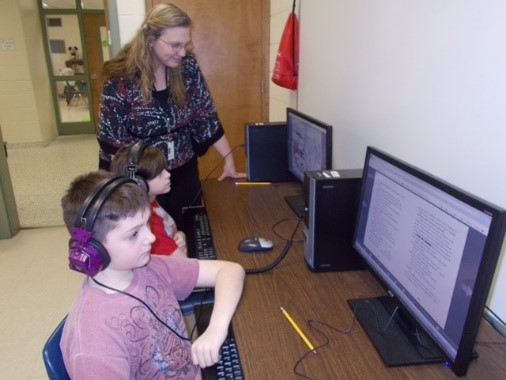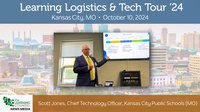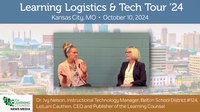Reading is the critical foundation for every student’s success in school, and subsequently their careers, but improving literacy education has been an ongoing challenge. For far too long, far too many students, particularly those from historically disadvantaged groups, have fallen below basic reading levels. Additionally, the gap between text complexity in K-12 education and college continues to widen.
More needs to be done to accelerate improvement. The good news is that there’s never before been such potential for educational transformation as there is today with the growth and accessibility of digital learning content.
Digital reading platforms offer the versatility for schools to efficiently and effectively individualize instruction for all students and improve learning. These platforms can result in greater motivation to read, less social stigmatism, increased literacy gains, and cost reductions at the district budget level.

Proven Instructional Practices
The success of any technology-based program relies on sound instructional methods. It also must reinforce the teacher as the central figure and facilitator of student learning. Research shows that there are several keys to improving literacy skills that schools and teachers can employ in the classroom :
• When students are given the opportunity to choose texts based on their interests they are more motivated to read voluntarily and leads to reading gains.
• Targeting reading levels that provide students with the appropriate level of challenge, but is not too frustrating, promotes growth. Students become better readers when they are continually challenged with increasingly complex texts based on their individual needs.
• Deliberate and frequent reading practice is a requisite for students to become better readers.
• Combining various methods such as modeled reading, assisted reading, wide reading and deep (repeated) reading into instruction can result in improved reading fluency and comprehension.
• Using multiple measures of assessment provides a more accurate reflection of a student’s reading ability than does a single test on a particular day. In other words, by monitoring the growth of a student’s true reading abilities over time, we, as educators, are able to better track a student’s trajectory toward college and career readiness.
Digital literacy programs addressing these key components will have better results, faster.
Well-Planned Digital Transition at Paulding County School District
Successful transition from print to digital reading requires careful planning and collaboration among district staff, teachers and the curriculum provider. An example, where literacy results were improved through effective collaboration and planning, is Paulding County School District. They utilized the following best practices to ensure a smooth implementation and a program in which students thrive:
• Create a sustainable infrastructure. Paulding County School District with the support of its community has continued to meet the demands of its growing population with reciprocal development to build new schools and renovate others so students have access to contemporary education opportunities, including technology improvements, such as wi-fi, tablets and laptops. The district also offers a bring-your-own-technology program to allow students to use devices from home for classroom learning. The district is committed to continuous improvement based on its strategic plan.
• Professional development is not optional. With the support of myON, Paulding County provided training, professional development and ongoing support to its teachers. Even the most intuitive technology systems require coaching on how to incorporate them into the classroom in ways that are meaningful and effective.
• Invite parents to participate early on and maintain communication. Parental involvement in reading is a critical determinate of student literacy. Paulding provided access to digital reading program beyond the classroom walls so every student, including their family members, were able to access high quality, authentic books to foster family reading time.
• Conduct a targeted rollout. Start with a pilot program and evaluate its efficacy in meeting stated goals before expanding to other schools or grade levels. Modify the program based on initial results and feedback and over time as needed to maintain success.
• Celebrate and share success. Like reading recognition programs for print books, it’s just as important to award students for reading digital books. Honor students who’ve logged the most minutes reading or completed the most books online. Celebrate these successes regularly and share it with the community to build awareness of the program and gains students are making.
• Combine print and digital. While students expect to learn in digital environments, it’s not the only medium they’ll encounter, and learning to read both print and digital text is a valuable skill needed for college and career readiness.
Promising Results
To increase reading achievement and support a growing and increasingly diverse body of students, Paulding County School District implemented myON™, a personalized reading environment that matches students’ interests and reading level and tracks their reading growth. The program offers more than 7,000 interactive digital books and reading supports, including audio, text highlighting and an embedded dictionary.

Paulding rolled out the myON program in May 2014 to all of their 19 elementary schools in grades 3-5. Almost immediately, the program received positive responses from parents, students and teachers and gained rapid growth. Based on the early successes, the district expanded the reading program to all of its middle schools.
“In the first seven months using the reading programs of myON,” stated Laura Leigh Rambauch, Paulding County Assistant Principal at Herschel Jones Middle School, “students at our 27 elementary and middle schools have read more than 321,647 books and logged over 55,000 hours of reading.”
A review of tests showed that every grade level, from grades 3-8, achieved gains in Lexile reading scores, by as much as 70 points in 3rd and 5th grade. “Students have a visible motivation to read, throughout these past seven months, they’ve increasingly strengthened their reading proficiency and stamina,” said Debbie Kelly, District Social Studies Curriculum Coordinator.
Administrators at Paulding stated that if they were to have purchased the books to implement this program, the cost would have been well over a million dollars based on the average cost of school library books. “The district is able to provide each of our schools a high-quality digital reading program at a fraction of the cost,” stated Nebo Elementary Principal Kelli Day.
Through the Paulding County School District’s digital reading program, educators can individualize literacy paths for their students, and administrators have the ability to monitor and forecast reading growth from the class to district level. The program is available 24/7 on any device to help students continue to develop reading proficiency, complexity and independence. In only half of a school year, the district has made significant literacy gains while saving a significant amount of time and money.











